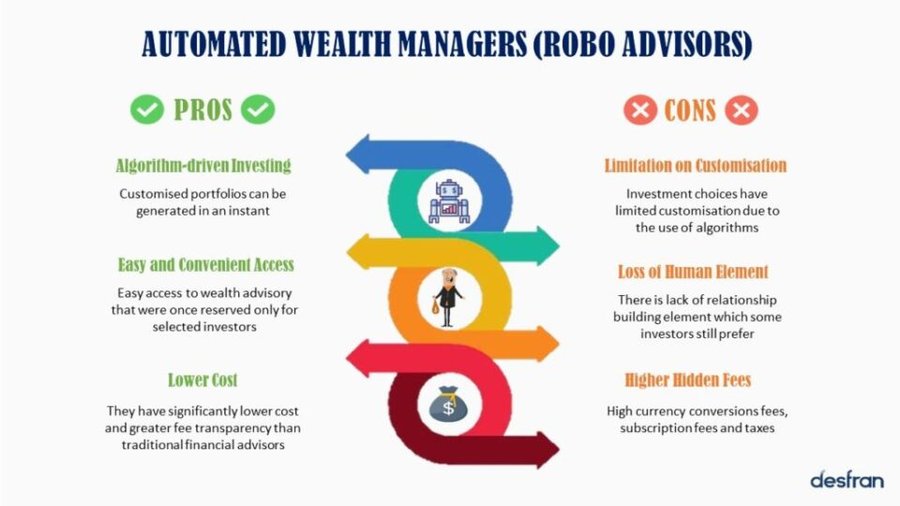In an era defined by technological advancements and a growing need for efficient financial management, robo-advisors have emerged as a prominent solution. These automated platforms leverage algorithms and data-driven strategies to provide investment advice and portfolio management services. While they offer a plethora of benefits, they also come with their fair share of drawbacks. In this 2000-word exploration, we will delve into the world of robo-advisors, examining the advantages they bring to the table and the limitations that investors should be mindful of.
The Rise of Robo-Advisors
The financial industry has undergone significant transformations over the past decade, with technology playing a pivotal role. One of the most notable developments is the rise of robo-advisors. These digital investment platforms cater to both novice and experienced investors, promising convenience, accessibility, and cost-effectiveness.
Understanding Robo-Advisors
Robo-advisors, as the name suggests, are automated financial advisors. They utilize algorithms and software to provide investment recommendations and manage portfolios on behalf of clients. This technology-driven approach has disrupted the traditional financial advisory landscape, making it easier for individuals to invest without the need for a human advisor.
Benefits of Robo-Advisors
1. Accessibility and Affordability
One of the most significant advantages of robo-advisors is their accessibility. They remove barriers to entry that have traditionally discouraged many from seeking professional financial advice. Investors with limited capital can now access diversified portfolios without hefty account minimums.
Robo-advisors are also cost-effective. Their fee structures are typically lower than those of human financial advisors, making them an attractive option for cost-conscious investors.
Read more: Robo-Advisors in the Wealth Management Industry: Transforming the Landscape
2. Diversification and Risk Management
Diversification is a key strategy for managing risk in investment portfolios. Robo-advisors excel in this regard. They use sophisticated algorithms to spread investments across various asset classes, reducing the impact of poor performance in any single investment.
Additionally, robo-advisors continuously monitor portfolios and make adjustments based on market conditions and the client’s financial goals. This active management contributes to effective risk management.
3. Convenience and Automation
Investing through a robo-advisor is incredibly convenient. Investors can set up accounts and manage their portfolios online, often from the comfort of their homes or mobile devices. This automation streamlines the investment process, saving investors time and effort.
4. Transparency
Robo-advisors provide transparency in portfolio management. Clients can typically access detailed information about their investments, including asset allocation, performance, and fees, through user-friendly interfaces. This transparency fosters trust between clients and their automated advisors.
5. Emotional Discipline
Human investors are prone to emotional decision-making, especially during market volatility. Robo-advisors, on the other hand, operate without emotions. They make decisions based on data and predetermined algorithms, which helps prevent impulsive and often detrimental investment choices.
Drawbacks of Robo-Advisors
While robo-advisors offer numerous benefits, they are not without their drawbacks and limitations. It’s essential for investors to consider these factors when deciding whether to use automated investment platforms.
1. Lack of Personalization
Robo-advisors rely on algorithms to create and manage portfolios. While they take into account factors such as risk tolerance and financial goals, they may not fully address an individual’s unique circumstances and preferences. Investors with complex financial situations or specific requirements may find the one-size-fits-all approach of robo-advisors limiting.
2. Limited Human Interaction
For some investors, the absence of human interaction can be a drawback. Robo-advisors operate solely through digital interfaces, which means investors miss out on the personalized guidance and expertise that human financial advisors can provide. This lack of human touch can be particularly challenging during significant life events or market turbulence when emotional support and customized advice are valuable.
3. Algorithmic Risk
Robo-advisors heavily rely on algorithms to make investment decisions. While these algorithms are designed to optimize returns and manage risk, they are not infallible. Sudden and unexpected market events or systemic algorithmic errors can lead to suboptimal performance or financial losses.
4. Limited Investment Options
Robo-advisors typically offer a range of pre-built portfolios based on risk tolerance and financial goals. While this approach simplifies investing for many, it may limit the flexibility for those who wish to invest in unconventional assets or pursue unique strategies.
Read more: Robo-Advisors and Personal Finance: A Transformative Partnership
5. Scalability Issues
As robo-advisors gain popularity, some platforms may experience scalability challenges. High demand can strain the capacity of automated systems, potentially leading to slower response times and customer service issues.
The Evolving Landscape
Despite the drawbacks, robo-advisors continue to evolve and expand their offerings. To remain competitive and address some of the limitations mentioned above, many robo-advisor platforms are incorporating new features and services.
Hybrid Models
Some firms are adopting hybrid models that combine the strengths of robo-advisors with human advisors. This approach provides clients with access to both automated portfolio management and personalized human advice when needed, offering a well-rounded solution.
Specialized Portfolios
To cater to investors with specific preferences or ethical considerations, some robo-advisors offer specialized portfolio options. These portfolios may focus on sustainable investing, socially responsible investing, or other niche strategies.
Enhanced Education
To bridge the gap between digital interaction and human guidance, robo-advisors are investing in educational resources. These resources help investors better understand their financial goals and investment strategies, empowering them to make informed decisions.
Conclusion
Robo-advisors have undoubtedly disrupted the world of financial advisory services, democratizing access to professional investment management. Their benefits, including accessibility, affordability, diversification, and convenience, have made them a popular choice for many investors.
However, investors must also consider the drawbacks, such as limited personalization, lack of human interaction, and algorithmic risk. Whether robo-advisors are the right choice depends on individual preferences, financial goals, and risk tolerance.
As the financial technology landscape continues to evolve, it’s likely that robo-advisors will adapt and address some of these limitations. Hybrid models, specialized portfolios, and enhanced education are steps in the right direction to offer more comprehensive solutions to investors.
In conclusion, robo-advisors have reshaped the investment landscape and will continue to play a significant role in the future of financial services. Whether you embrace this technology or opt for a more traditional approach, the key is to make informed choices that align with your financial objectives and values.
Image Source: Desfran




